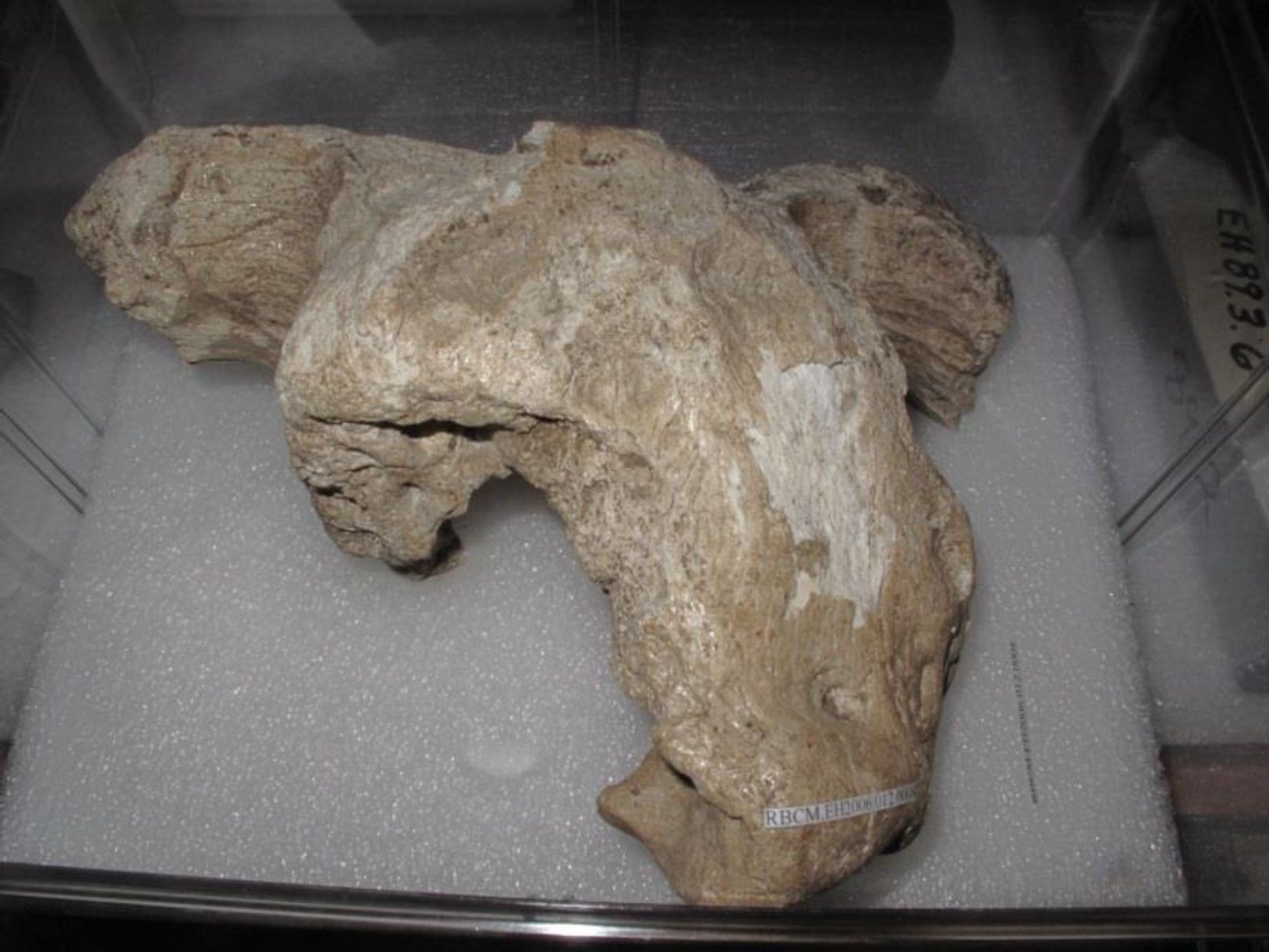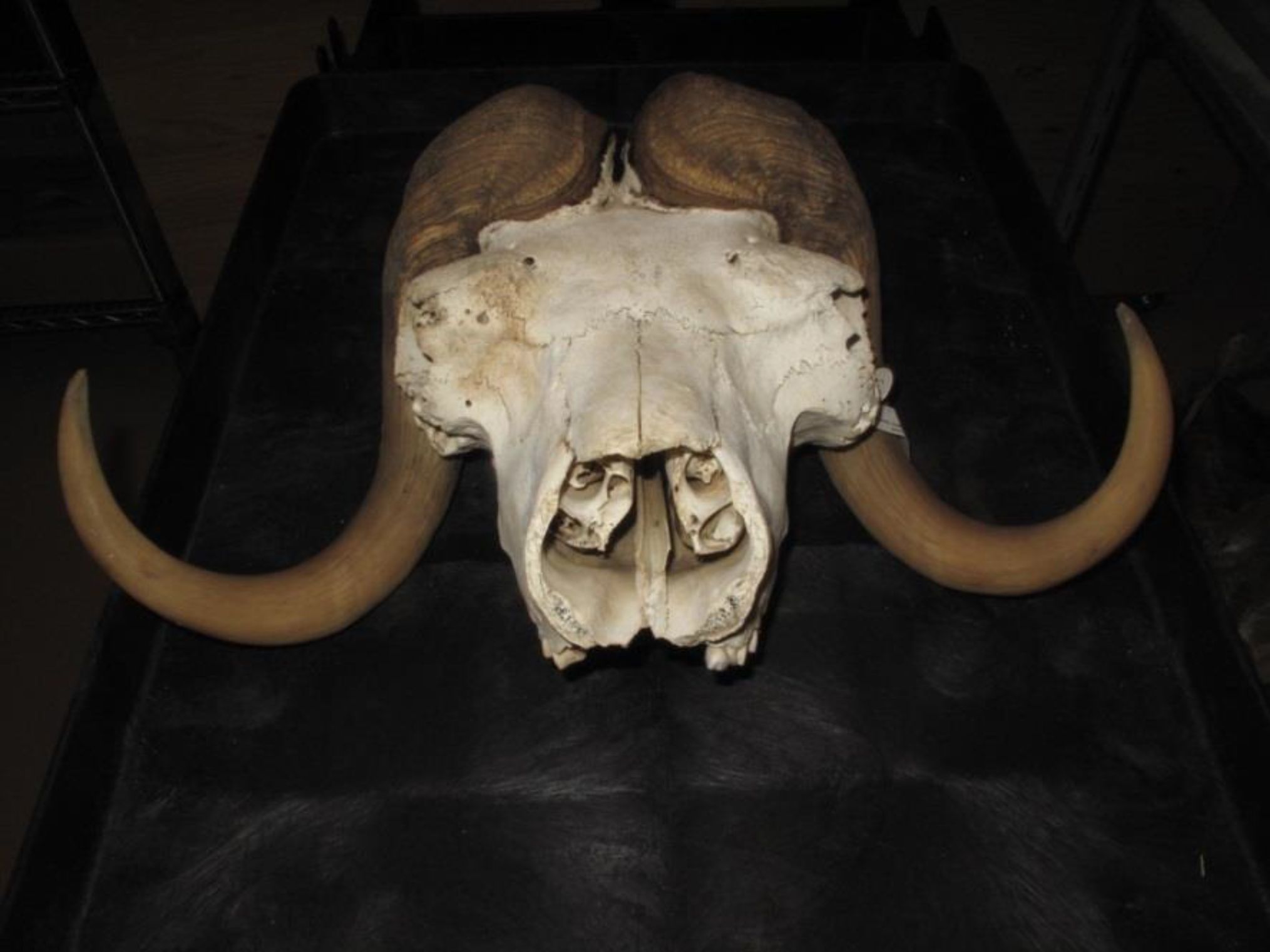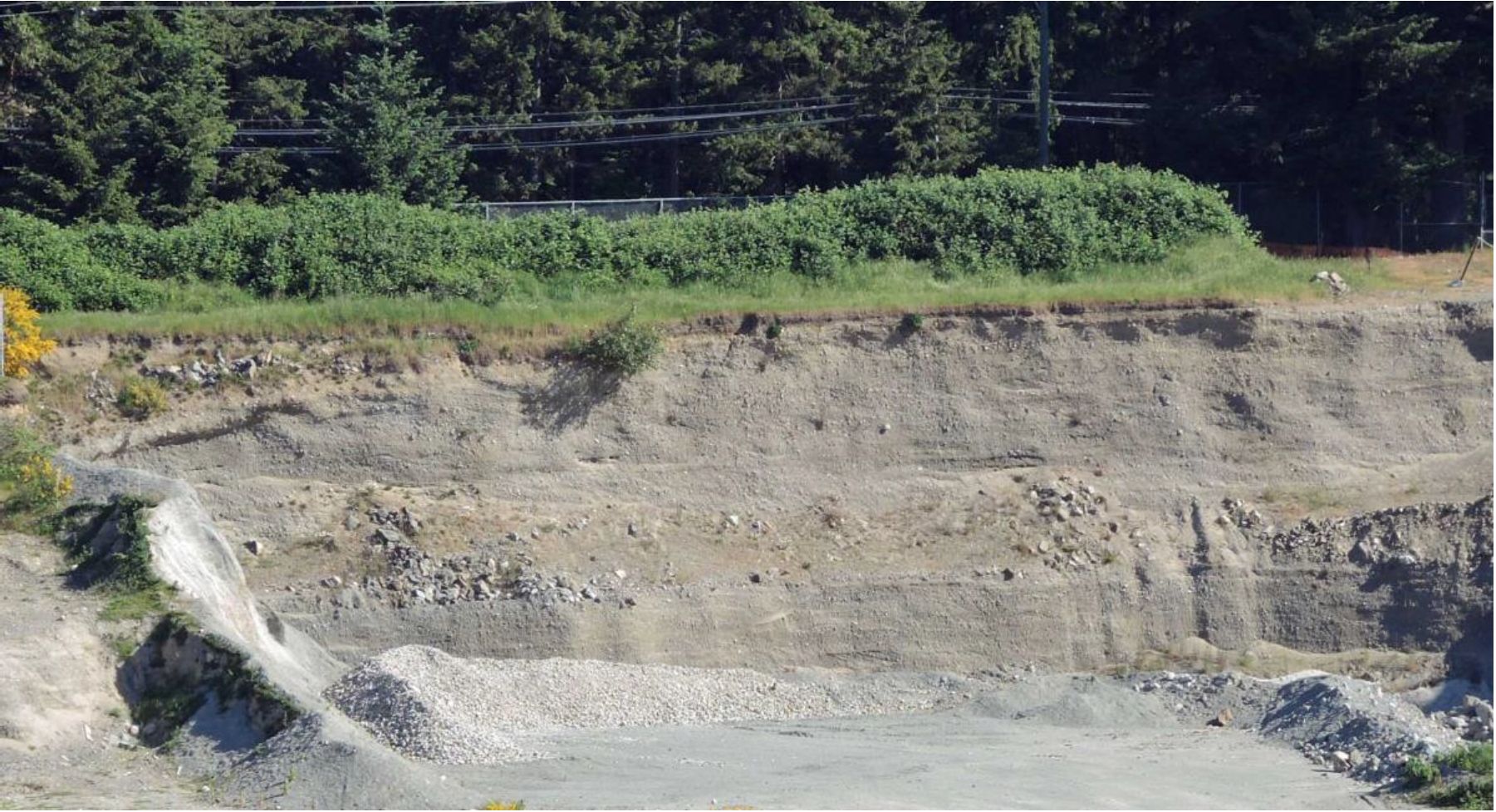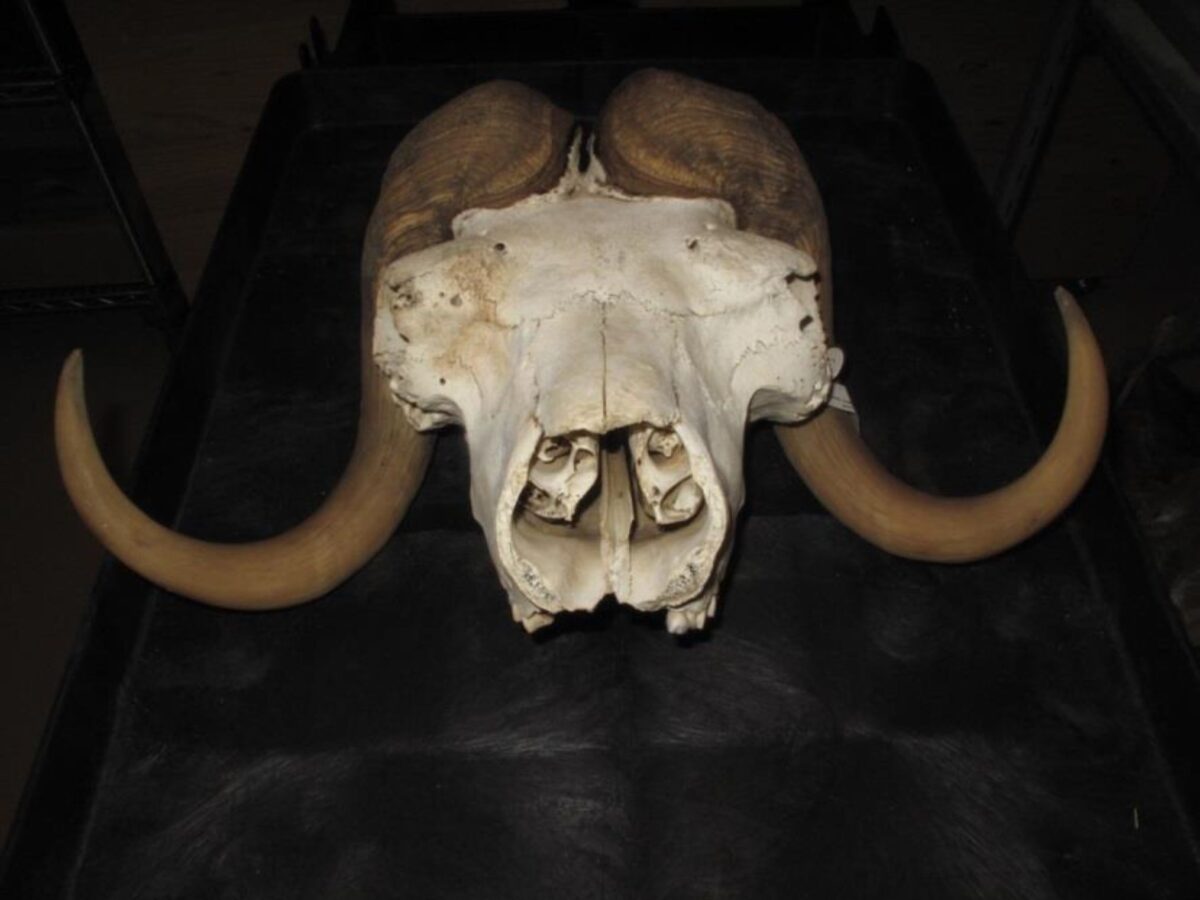May 6, 2016?
By Grant Keddie
One of the most exciting fossil finds on Vancouver Island is the skull of an extinct muskox called Symbos cavifrons (1). It was collected in 1969, from the lower half of a 15 meter thick gravel deposit at the bottom of the Butler Brothers gravel pit on the Saanich Peninsula, 12km north of Victoria. Overlaying this lower layer were 6 meters of sediment with a lower glacial till, then silts and sands and another till layer near the top.




The only other Symbos fossil from British Columbia that has survived in a Museum collection is a skull from Dease Lake in the northern part of the Province. Details of these finds were published in 1975, by Paleontologist Richard Harington, then of the National Museum of Natural Sciences (2). The Saanich fossil can be estimated to date to about 17,000 to 22,000 years ago, based on dated fossils found in similar deposits only one km to the east.
A third Symbos skull was found around 1937 near Telegraph Creek in northern B.C., but its present whereabouts is unknown. The Provincial Museum director Francis Kermode sent a letter on January 11, 1938 to T.W. S. Parsons the Assistant Commissioner of the British Columbia Provincial Police:
“Dear Mr. Parsons: I am in receipt of your letter of the 6th instant with the letter from Constable Blakiston-Gray of Telegraph Creek regarding a fossil found by Mr. R. H. Johnson in that vicinity enclosed. I had Dr. Cowan [Dr. Ian McTaggart-Cowan, curator of Vertebrate Zoology] go over to Vancouver and interview this gentleman and see the specimen. He reports to me as follows: “The fossil skull referred to is undoubtedly that of a muskox, and though the specimen is very fragmentary it would appear to belong to the extinct genus Symbos. We offered to purchase the specimen from Mr. Johnson but found that he had too exaggerated an idea of its worth. This find is apparently the first instance of the occurrence of the genus Symbos in British Columbia. It is quite common however in glacial deposits in Alaska and in the Yukon.”(3).
Symbos was taller and more slender than the tundra muskox (Ovibos moschatus) that now occupies parts of northern Canada and Greenland. Symbos also had a relatively massive “helmet” at the base of its horns and more flaring horns – resulting in it being called the helmeted muskox. It was adapted to warmer conditions than the living muskox -parkland or steppe grassland environments were its home.
Modern wild herds of the tundra muskox once had a wider distribution across the Siberian Arctic during the late Pleistocene and only migrated to Greenland in the second century A.D. Recent evidence from the Taymyr Peninsula in the Polar region of Russia has shown that muskox existed into the post glacial Holocene period possibly as late as 3000 years ago(4). They have recently been re introduced to this and other regions of Russia, as well as Alaska and Quebec.
During the Pleistocene the more southern Symbos cavifrons muskox had a wider distribution across Siberian to the eastern United States. By studying the genetic makeup of living muskox and fossil bones dating back 60,000 years ago scientists were able to show that muskox populations have undergone several periods of expansion and contraction(5).
Studying the DNA can provide us with information about population sizes and movements of muskox. A decrease in genetic diversity is usually an indication of a decrease in numbers. The diversity was much higher in the past during the Pleistocene. Muskox began a population decline about 65,000 years ago, long before human hunters were part of their world.
There were local extinctions in the far north 45,000 years ago and an increase in genetic diversity 30,000 years ago when the northern world began to get colder. A further reduction occurred about 18,000 years ago after the peak of the last glacial period. Historic observations inform us that Muskox are sensitive to both climate warming and fluctuations in temperature. Humans likely played a role in their final demise in Siberia, but drastic declines in muskox populations, previous to modern times in North America, was clearly due mostly to warming climate rather than to human hunting (5&6&7).
Genetic studies have identified two classes of haplotypes – that is genetic groups that are distantly related but relatively different from each other. One of these, called “Surviving haplotypes”, was closely similar or identical to haplotypes found in modern muskoxen and extended back in time to about 22,000 years ago. This type was found in all New World samples as well as some samples from northeastern Asia. The other “Extinct haplotypes”, dated between about 44,000 and 18,000 years ago and were identified only in those muskox bones from the Taimyr Peninsula and New Siberian Islands in northeastern Asia(8).
It is clear that muskox on the eastern portion of the Beringian continent had more favourable habitats, with fewer humans, into which they could expand than those of their relatives in Siberia to the west. Humans played an increasing role in reducing muskox populations in the last 2000 years (9).
During the late Pleistocene we saw the demise of very large animals such as the woolly mammoth, mastodon, horse and Saiga antelope in Eastern Beringia (now North America), but like the muskox, caribou and bison survived to the present day. The horse and Saiga antelope died out in Eastern Beringia (North America) but did survive in western Beringia (now Asia).
As more fossil muskox are found in the southern regions of their ancient distribution and DNA analysis of Megafauna becomes a more common practice, we will be able to see more clearly where the muskox fossils from British Columbia fit into the bigger picture of the late Pleistocene landscape.
References
(1) (RBCM Earth History Collection EH2006.012.0008; old number 69:014).
(2) Harington, C.R. 1975. Pleistocene Muskoxen (Symbos) from Alberta and British Columbia. Canadian Journal of Earth Sciences. 12(6)903-919.
(3) Kermode, Francis. 1938. Letter of January 11, 1938 to T.W.S. Parsons, Assistant Commissioner of the British Columbia Provincial Police. (Letter file 3224).
(4) Siberian Times. 2013. July 24. Cave in Northern Siberia Shows the musk ox survived longer in the region than experts believed. http://siberiantimes.com/ecology/casestudy/news/cave-in-north
(5) Campos, Paula F., Eske Willersleva, Andrei Sherb,1 , Ludovic Orlandoc, Erik Axelssona, Alexei Tikhonovd, Kim Aaris-S0rensena, Alex D. Greenwoode,2, Ralf-Dietrich Kahlkef, Pavel Kosintsevg, Tatiana Krakhmalnayah, Tatyana Kuznetsovai, Philippe Lemeyj, Ross MacPheek, Christopher A. Norrisl, Kieran Shepherdm, Marc A. Suchardn, Grant D. Zazulao, Beth Shapirop, and M. Thomas P. Gilbert. 2010. Ancient DNA analyses exclude human as the driving force behind late Pleistocene musk ox (Ovibos moschatus) population dynamics. Proceedings of the National Academy of Sciences of the United States of America. 107:12:5675-5680.
(6) Markova, A. K. et. al. 2015. Changes in the Eurasian distribution of the musk ox (Ovibos moschatus) and the extinct bison (Bison priscus) during the last 50 ka BP. Quaternary International, 378, August 18. Pages 99-110.
(7) Lorenzen, Eline D. et al. 2011. Speciesspecific responses of Late Quaternary megafauna to climate and humans. Nature. 479(7373): 359-364.
(8) MacPhee, Ross, D.E., Alexei N. Tikhonov, Dick Mol, and Alex D. Greenwood. 2005. Late Quaternary loss of genetic diversity in muskox (Ovibos). BMC Evolutionary Biology, 5:49.
(9) Lent, Peter C. 1999. Muskoxen and Their Hunters. A History. Volume 5. Animal Natural History Series. University of Oklahoma Press, Norman.
